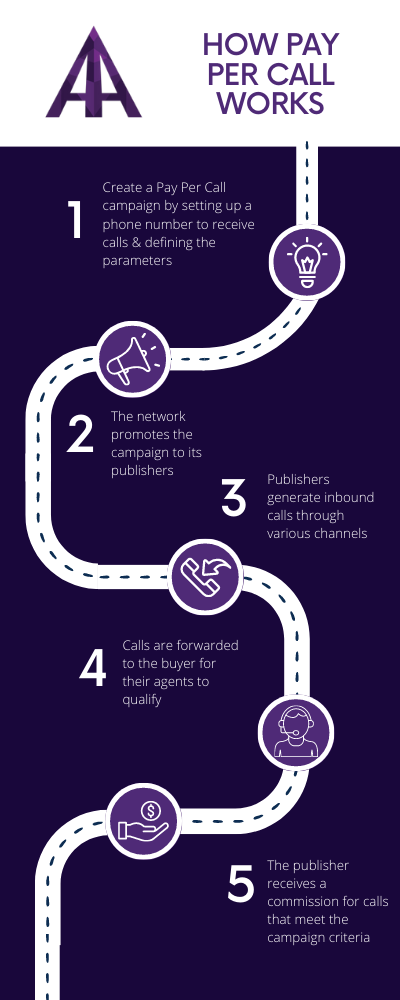The Ultimate Guide to Pay Per Call Marketing
By Ben Maguire
Most business owners and executives will agree that ensuring a steady inflow of customers and revenue is one of their most pressing needs. To rise to this essential challenge, companies can utilize performance marketing — a marketing model in which advertisers pay for tangible results — to drive qualified leads and sales.
Among the numerous subsets of performance marketing, Pay-Per-Call (PPC) stands out as one of the most effective strategies, particularly for consumer-facing businesses that can convert inbound calls into sales. So, in this guide, we’ll provide a thorough explanation of pay-per-call marketing and its attendant considerations, including:
- What is pay-per-call marketing?
- How does pay-per-call work?
- Why should you use pay-per-call?
- Launching a pay-per-call campaign
- Partnering with a pay-per-call agency
- …and more
With this guide, you’ll gain a solid understanding of pay-per-call marketing, ultimately equipping you to make an informed decision about whether (and how) to incorporate pay-per-call campaigns within your company’s marketing mix.
To start…
What Is Pay-Per-Call Marketing?

To reiterate, pay-per-call is a form of performance marketing — meaning that it’s a performance-based model in which advertisers pay for specific, tangible outcomes (in this case, qualified phone calls).
There are typically three parties involved in a pay-per-call campaign: an advertiser, a pay-per-call network, and a group of external publishers. The advertiser pays the publishers for each qualified call they generate — and this exchange is facilitated by a third-party PPC network such as Aragon Advertising. It’s also possible for advertisers and publishers to engage without the use of a third-party network, although this is less common.
The pay-per-call model enables businesses to buy customer calls directly instead of investing in branding/awareness campaigns that produce less concrete results. In a pay-per-call campaign, the price of each call is fixed, so the advertiser knows exactly how many calls their budget will yield. For example, if a campaign has a $50 cost-per-call and the campaign budget is $10,000, then the advertiser can expect 200 qualified calls.
If, for any reason, a PPC campaign generates fewer calls than anticipated, the advertiser would be billed accordingly. However, the maximum campaign budget is determined beforehand, so the advertiser will never spend more than they planned. This dynamic makes pay-per-call a highly predictable and reliable marketing channel from an ROI perspective.
The History of Pay-Per-Call
Although it has evolved into a largely digital channel, pay-per-call marketing actually predates the Internet. Pay-per-call roots can be traced back to TV commercials and direct response print ads that prompted consumers to dial a phone number to request more information or place an order.
Then, in the 1990s, the rise of the internet forever changed how businesses engage prospects — and pay-per-call was naturally included in the transition. This development gave PPC marketers access to a new breed of promotional channels beyond traditional media, including websites and digital ad placements.
And, as the internet rapidly transformed, so did the means by which pay-per-call phone numbers could be promoted. In 2010, Google introduced Click-to-Call ads for mobile devices, which fostered an even more seamless connection between consumers and advertisers. In 2015, Facebook followed suit with its version of Call Ads, encouraging pay-per-call marketing within the burgeoning realm of social media.
With these advancements (and many others including display ads and call center technology) pay-per-call has matured into a sophisticated and highly accessible modern marketing channel — and companies that invest in PPC stand to reap tremendous benefits. But, before we dive deeper into the advantages of pay-per-call, let’s take a closer look at the inner workings of a PPC campaign.
How Does Pay-Per-Call Work?
To execute a pay-per-call campaign, an advertiser will need to set up a special phone number to receive calls. This number is known as a virtual number or DID (Direct Inward Dialing) number. Direct Inward Dialing is used to automatically route inbound calls to extension numbers, which can be VoIP, mobile, or fixed lines.
In addition to setting up a DID number, the advertiser will also need to specify the parameters for the campaign. There are numerous parameters that can be customized depending on the advertiser’s preferences, including cost-per-call, campaign dates, lead payment criteria, lead volume, location, hours of operation, and more.
While agreements can be made directly between advertisers and publishers, pay-per-call campaigns are generally facilitated by a pay-per-call network or platform. The network/platform will provide unique, trackable phone numbers to be used for the campaign. Publishers will then promote these unique numbers to drive inbound call traffic that is ultimately routed to the advertiser’s sales team after passing through a call center to be qualified.
Each call the publishers generate will have to meet the qualifying criteria to be counted as a payable lead. Pay-per-call campaigns usually operate on a duration basis, meaning that a set amount of time must elapse on the call (e.g. 30 seconds, 1 minute, etc.) to trigger a payable event. This helps filter out unqualified leads and dialing mistakes, thereby ensuring lead quality.
Once a pay-per-call campaign is launched, call-tracking technology will attribute calls to individual publishers and promotions. It’s also possible to apply advanced tracking features such as call recording and analytics. With call recording, managers can assess adherence to sales protocols. And, with call analytics, call outcome data can be reviewed to guide the strategic optimization of future campaigns.

Why Should You Use Pay-Per-Call?
Pay-per-call marketing is highly advantageous for several reasons — all of which directly impact revenue and profitability. Here are some of the most notable benefits of PPC campaigns:
1) High-quality, high-intent leads
Pay-per-call, by its very nature, produces the most valuable type of leads a business can obtain: inbound phone calls from high-intent prospects. When a consumer calls a PPC phone number, they’re inherently interested in the advertiser’s product/service at that exact moment. This creates a very high-probability selling opportunity for reps to capitalize on.
By contrast, less immediate inbound lead generation channels like email and form-fills can’t match the urgency and interactivity of a phone call. And outbound methodologies — which are generally disruptive — tend to have far lower conversion rates, making sales opportunities few and far between. So, when compared to other approaches, pay-per-call excels in terms of lead quality and overall marketing efficacy.
2) Increased sales and expanded market reach
Because of the lead quality described above, pay-per-call is a powerful sales driver that can have a sizable impact on companies’ top-line revenue. But lead quality is only one piece of the equation: another factor to consider is the expanded market reach that external publishers can provide.
It’s common for publishers to have access to large audiences. So, teaming up with publishers allows advertisers to tap into new and broadened market segments that they likely wouldn’t have been able to reach otherwise. And, if an advertiser partners with a pay-per-call network, the aggregate audience will extend even further since PPC networks contain numerous publishers housed under one roof.
3) Cost-effectiveness and ROI
Perhaps the most attractive feature of pay-per-call is its performance-based structure. As we’ve discussed, with pay-per-call, advertisers only pay for qualified calls that meet certain criteria. This arrangement not only ensures lead quality; it also empowers advertisers to be very precise and calculated with their marketing spend by only paying for results.
In other words, with pay-per-call, advertisers always know how many leads they will obtain with their budget. And, given that pay-per-call leads are highly trackable, the ROI of each campaign can be concretely measured. Consequently, campaign ROI can be optimized via data-backed decisions, thus maximizing the cost-effectiveness of the channel as a whole.
Industries That Are Well-Suited to Pay-Per-Call

Many different types of businesses can benefit from pay-per-call marketing, but certain industries are a particularly good fit. Here are some of the most common verticals that we serve here at Aragon Advertising:
- Insurance
- Personal Finance
- Legal
- Home Services
These industries are prime candidates for pay-per-call because their sales funnels are fueled by consumer phone calls. For example, consumers who are interested in purchasing an insurance product will often want to talk to a representative to discuss questions related to coverage options and policy details. The same concept applies to personal finance products like credit cards and loans.
Similarly, consumers in need of legal services will usually want to speak with a live agent on the phone regarding their unique situation. And, when a consumer is shopping for home services, a phone call is typically the most convenient way to contact a service provider. The overarching theme here is that consumer phone calls are a quintessential sales channel for these industries, making pay-per-call marketing an ideal solution.
Pay-Per-Call Technology
Like all facets of the digital world, the evolution of pay-per-call in the last decade has been propelled by technological advancements. Smarter technology has allowed advertisers, publishers, and pay-per-call networks to be more calculated, efficient, and effective — and this has been mutually beneficial for all parties involved.
Here are three game-changing technologies that have emerged in the pay-per-call space in recent years:
Call Routing Algorithms
Call routing algorithms allow controllers to adjust the portion of call traffic that is sent to each advertiser. This allocation is based on several factors that ultimately boil down to the advertisers’ RPC (revenue per call). Call routing algorithms help networks optimize performance and ensure consistent lead volume/quality — especially when used in conjunction with the other technologies listed below.
Ping Post Solutions
Ping post technology transforms each call into a real-time auction that takes both bids and buyer-side availability into account. When a call comes in, microdata is “pinged” to multiple lead buyers who then automatically return a bid for that call based on the circumstances. The publisher then accepts the highest bid and routes the call to that buyer — all within a matter of seconds. This process improves publisher margins, advertiser ROI, and caller experience; ultimately benefiting the entire pay-per-call ecosystem.
Real-Time Bidding
Real-Time bidding and ping post capabilities are essentially two sides of the same coin. That is to say, both technologies are components of the real-time auction environment described above. With real-time bidding, advertisers can strategically adjust their bids in real-time based on additional data points that are appended to each call. For example, an advertiser may choose to raise its bid from $30 to $40 for calls from certain zip codes that yield particularly high-value or high-converting leads. In doing so, the advertiser can significantly improve its overall ROI by making more intelligent bids.
Pay-Per-Call Campaign Examples
To further clarify how pay-per-call works and how it’s applied in practice, let’s review two hypothetical campaign examples that illustrate some of the main principles we’ve been discussing.
Pay-Per-Call Campaign Example #1
A national insurance carrier is looking to increase the sales volume of one of its health insurance products. After selecting a reputable pay-per-call network to partner with, the company enters the marketplace offering $50 for calls that last at least 120 seconds. So, publishers will earn the $50 commission for each call they generate that meets the qualifying criteria (minus a small fee that goes to the network for hosting the transaction).
During the campaign setup, parameters such as location and operating hours are confirmed based on the insurance company’s circumstances and strategy. The insurance company opts to target California, Oregon, and Washington and specifies that its operating hours are from 8 am to 6 pm. Once the campaign is live, optimization data is used to decide which traffic sources are performing best — and adjustments can then be made to meet the insurance company’s KPIs.
Pay-Per-Call Campaign Example #2
A large home services provider is promoting its plumbing service in four Texas counties. After consulting its PPC network partner, the company determines that it will offer publishers a baseline rate of $30 for calls that last at least 30 seconds. However, the company’s historical data shows that it performs particularly well in two of the four counties it is targeting — so it wants to create a campaign strategy that reflects this.
To capitalize on the regional differences, the company elects to use real-time bidding technology to adjust the payment it offers for each call. With real-time bidding, the company is able to increase its bid from $30 to $40 in the two counties it performs best. This strategy allows the company to capture more market share in those regions (since its bids are more competitive) while maintaining a strong conversion rate — ultimately lifting the company’s aggregate pay-per-call ROI.
Promotional Methods & Traffic Sources
At its core, pay-per-call is built on publishers’ ability to generate qualified, high-intent phone calls. So, it’s helpful to understand the different marketing methods that publishers use to advertise PPC phone numbers and drive call traffic. Below is a list of the most common promotional channels that underlie the pay-per-call model.
- Search: Search engines like Google and Bing are often the first resource that consumers turn to for information. Consequently, these platforms are a key source of pay-per-call traffic, which can be derived from either organic search results or paid ads.
- Display: Display ads are a traditional internet marketing medium that can be thought of as digital billboards on websites. These ads can be highly targeted based on user browsing history and the context of the websites on which they appear.
- Email: Many people associate email marketing with spam. But, despite this stigma, 59% of consumers acknowledge that email marketing influences their purchase decisions. So, when used responsibly, email can produce powerful results.
- Social Media: As of 2023, there are now 4.5 billion social media users worldwide, and those users average nearly 2.5 hours per day on their favorite social media platforms. With such deep and widespread engagement, social media remains one of the best ways to reach an audience online.
- Mobile Ads: 60% of web traffic comes from mobile devices — so, virtually every digital marketing strategy needs to take mobile into account. Mobile ad types include in-app promotions, banners/interstitials, and mobile search ads.
- SMS: Web-based mobile ads aren’t the only way to market to consumers via their smartphones: SMS text messages can be an effective channel as well. This is especially applicable to pay-per-call since the end goal is to initiate a phone conversation.
- Push Notifications: Push notifications are yet another way to engage consumers on their mobile devices. When a user receives a push notification, a message will appear on their device’s home screen — and this can spur them to take action.
- TV & Smart TV: Television is a tried-and-true channel that has been at the heart of pay-per-call since its inception. And, more recently, internet-connected smart TVs have provided an abundance of new advertising opportunities.
- Radio: Finally, we have an old classic: radio. If you think radio advertising is outdated, consider this: in 2020, 83% of Americans over the age of 11 listened to terrestrial radio at least once a week. So, radio’s century-long streak as an influential medium is far from over.
While this list isn’t exhaustive, the channels included above are generally the main traffic sources that can be tapped into to promote a pay-per-call campaign. And on that note, let’s now explore the steps involved in launching a PPC campaign.
Launching a Pay-Per-Call Campaign

Every pay-per-call campaign is unique, but there’s a standard sequence of events that nearly all successful campaign launches have in common. Here’s what that process typically looks like:
Step 1: Establish the partnership(s)
To initiate a pay-per-call campaign, an advertiser must first identify which network/platform or publisher(s) they’d like to work with to implement the campaign. The advertiser may choose to partner with a third-party pay-per-call network or collaborate with publishers directly — although working with a network is usually a more streamlined approach.
Step 2: Define the product being sold
Once the advertiser has partnered with a pay-per-call network (or with publishers directly), the next step is to delineate the product or service that will be promoted. Clarity during this stage is vital, as vagueness can lead to confusion and problems down the road.
Step 3: Determine targeting, pricing, and KPIs
With a clear product/service description in place, the advertiser can then specify campaign parameters such as call volume, targeting (e.g. location), cost-per-lead, and payment criteria. The advertiser should also discuss KPI goals such as conversion rate, cost-per-acquisition (CPA), and return on ad spend (ROAS).
Step 4: Configure call routing/tracking and PPC tech
At this point, the campaign details have been confirmed and it’s time to transition into the execution phase. The advertiser (or the network) will need to set up the trackable phone numbers and call routing for the campaign, along with any advanced technologies such as ping post solutions and real-time bidding.
Step 5: Test the campaign to ensure proper function
Once the technical aspects of the campaign have been set up, tests should be performed to make sure everything is working correctly. Recruiting test traffic will allow stakeholders to assess the campaign configuration and the traffic sources in a live (but controlled) scenario.
Step 6: Launch and optimize to meet KPIs
When the above steps are complete, the campaign can then be launched to begin driving qualified inbound calls. As call traffic is generated, the results should be analyzed so that tactical refinements can be made to optimize the campaign based on the advertiser’s KPIs.
*Note: If you partner with a full-service PPC agency like Aragon Advertising, you’ll have access to an account manager and/or support team that can guide you through every step of the process. And, with that in mind, let’s now review some key considerations for choosing a pay-per-call agency.
Partnering With a Pay-Per-Call Agency
Selecting a pay-per-call agency is a critical decision that can greatly affect your overall success. So, it’s important to conduct a thorough evaluation before making a commitment. Here are five fundamental characteristics you should be looking for when evaluating potential agency partners:
- Expertise. The best pay-per-call agencies are industry leaders with a wealth of knowledge and experience. They aren’t just networks; they’re savvy consultants that can advise their clients on all matters related to pay-per-call.
- Reputation. Superior performance doesn’t go unnoticed, which is why the best pay-per-call agencies are well-known and recognized within the space. To analyze the current landscape, you can refer to mThink’s annual list of the top pay-per-call networks.
- Network. Quality agencies diligently handpick both the publishers and advertisers they work with. They typically look for long-term commitments from brands and publishers to form strong partnerships that revolve around constant improvement and transparency.
- Technology. Tech is a core component of modern pay-per-call marketing. Leading agencies offer cutting-edge technology to maximize campaign performance and ensure the best outcomes for both sides of the business.
- Customer Support. First-rate agencies provide excellent customer service and dedicated account managers who share their professional insight to give advertisers and publishers a competitive advantage in a crowded industry.
At Aragon Advertising, we work hard to embody the core features and values of a best-in-class pay-per-call agency. We grow our partners’ businesses as if they were our own, and this mindset has led us to be named mThink’s #1 PPC agency for 6 years in a row.
Join the Aragon Pay-Per-Call Community
Want to learn more about pay-per-call and get more involved in the space? If so, be sure to check out our Facebook group, Pay Per Call Central. You can post offers you’re looking for or want to fill, have discussions about problems/solutions you’ve encountered, and connect with other like-minded professionals. If you have any questions about the community, or about pay-per-call in general, please don’t hesitate to reach out — our team would be more than happy to assist you!
Recent Posts
- Inbound vs. Outbound Leads: What’s the Difference & How to Select the Best Approach for Your Business
- The Dos and Don’ts of Outbound Lead Generation: Best Practices and Common Pitfalls Businesses Should Avoid
- Converting Calls into Customers: How to Scale Your Business by Leveraging an Agency Call Center’s Expertise
- What to Look for in an Affiliate Network: A Guide for Advertisers
- How to Get Started with Pay-Per-Call Marketing: A Complete Guide for Advertisers
Recent Comments
- on How to Form a Pay-Per-Call Strategy: Research, Setup, Advertising, and Analytics
- on How to Form a Pay-Per-Call Strategy for Advertisers
- on 5 Ad Copy Tips for Marketers and Brands
- on The Ultimate Guide to Pay Per Call Marketing
- on Pay-Per-Call Strategy for Affiliates: Maximizing Profits with Expert Insights
